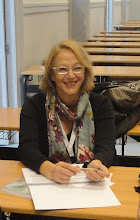Hi there! Just got this mail a few days ago about the relatively recent tendency in the Spanish language to create a feminine gender for some professions. From my point of view she started up pretty well, showing her good education background (unless the victims of the LOGSE), but then.... well, you can check it out by yourselves and give some feedback about the issue. Do you agree that we should say "presidentE" to a woman?CONTRA LA TONTUNA LINGÜÍSTICA , UN POCO DE GRAMÁTICA BIEN EXPLICADA
Yo no soy víctima de la LOGSE. Tengo 48 años y he tenido la suerte de estudiar bajo unos planes educativos buenos, que primaban el esfuerzo y la formación de los alumnos por encima de las estadísticas de aprobados y de la propaganda política. |
En párvulos (así se llamaba entonces lo que hoy es "educación infantil", mire usted) empecé a estudiar con una cartilla que todavía recuerdo perfectamente: la A de "araña", la E de "elefante", la I de "iglesia" la O de "ojo" y la U de "uña".
Luego, cuando eras un poco más mayor, llegaba "El Parvulito", un librito con poco más de 100 páginas y un montón de lecturas, no como ahora, que pagas por tres tomos llenos de dibujos que apenas traen texto. Eso sí, en el Parvulito, no había que colorear ninguna página, que para eso teníamos cuadernos.
En EGB estudiábamos Lengua Española, Matemáticas (las llamábamos "tracas" o "matracas") Ciencias Naturales, Ciencias Sociales, Plástica (dibujo y trabajos manuales), Religión y Educación Física. En 8º de EGB, si en un examen tenías una falta de ortografía del tipo de "b en vez de v" o cinco faltas de acentos, te suspendían.
En BUP, aunque yo era de Ciencias, estudié Historia de España (en 1º), Latín y Literatura (en 2º) y Filosofía (en 3º y en COU). Todavía me acuerdo de las declinaciones (la 1ª.: rosa, rosa, rosa, rosae, rosae, rosa en el singular; -ae, -ae, -as, -arum, -is, -is, en el plural; la segunda;-us, -e, -um, -i, -o, -o, en el singular; -i, -i -os, -orum, -is, -is, en el plural; no sigo que os aburro), de los verbos (poto, potas, potare, potavi, potatum, el verbo beber), de algunas traducciones ("lupus et agni in fluvi ripa aqua potaban; superior erat lupus longeque agni": el lobo y el cordero bebían agua en el río; el lobo estaba arriba, lejos del cordero; "mihi amiticia cum domino erat": yo era amigo del señor).
Leí El Quijote y el Lazarillo de Tormes; leí las "Coplas a la Muerte de su Padre" de Jorge Manrique; a Garcilaso, a Góngora, a Lope de Vega o a Espronceda...
Pero, sobre todo, aprendí a hablar y a escribir con corrección. Aprendí a amar nuestra lengua, nuestra historia y nuestra cultura. Aprendí que se dice "Presidente" y no Presidenta, aunque sea una mujer la que desempeñe el cargo.
Y... vamos con la Gramática.
En castellano existen los participios activos como derivado de los tiempos verbales. El participio activo del verbo atacar es "atacante"; el de salir es "saliente"; el de cantar es "cantante" y el de existir, "existente". ¿Cuál es el del verbo ser? Es "el ente", que significa "el que tiene entidad", en definitiva "el que es". Por ello, cuando queremos nombrar a la persona que denota capacidad de ejercer la acción que expresa el verbo, se añade a este la terminación "-nte".
Así, al que preside, se le llama "presidente" y nunca "presidenta", independientemente del género (masculino o femenino) del que realiza la acción.
De manera análoga, se dice "capilla ardiente", no "ardienta"; se dice "estudiante", no "estudianta"; se dice "independiente" y no "independienta"; "paciente", no “pacienta"; "dirigente", no dirigenta"; "residente", o "residenta”.
Y ahora, la pregunta del millón: ¿nuestros políticos y muchos periodistas (hombres y mujeres, que los hombres que ejercen el periodismo no son "periodistos"), ¿hacen mal uso de la lengua por motivos ideológicos o por ignorancia de la Gramática de la Lengua Española? Creo que por las dos razones. Es más, creo que la ignorancia les lleva a aplicar patrones ideológicos y la misma aplicación automática de esos patrones ideológicos los hace más ignorantes (a ellos y a sus seguidores).
Me gustaría que esto llegue finalmente a esos ignorantes semovientes (no "ignorantas semovientas", aunque ocupen carteras ministeriales).
Lamento haber aguado la fiesta a un grupo de hombres que se habían asociado en defensa del género y que habían firmado un manifiesto... Algunos de los firmantes eran: el dentisto, el poeto, el sindicalisto, el pediatro, el pianisto, el golfisto, el arreglisto, el funambulisto, el proyectisto, el turisto, el contratisto, el paisajisto, el taxisto, el artisto, el periodisto, el violinisto, el taxidermisto, el telefonisto, el masajisto, el gasisto, el trompetisto, el violinisto, el maquinisto, el electricisto, el oculisto, el policío del esquino y, sobre todo, ¡el machisto!
FEMINISM? Sarah Saiz (2009-2010)
Labels: Discourse and Gender





